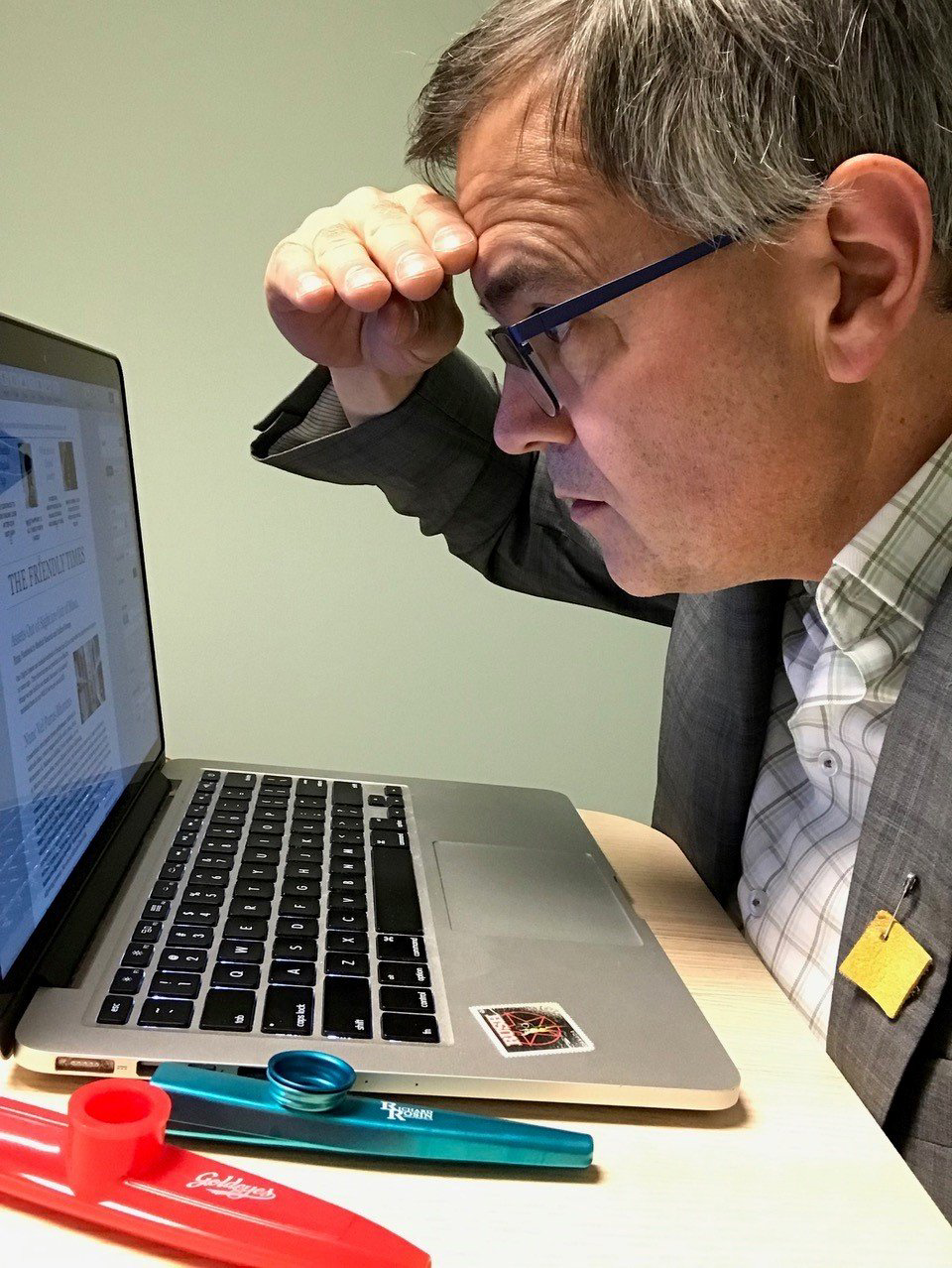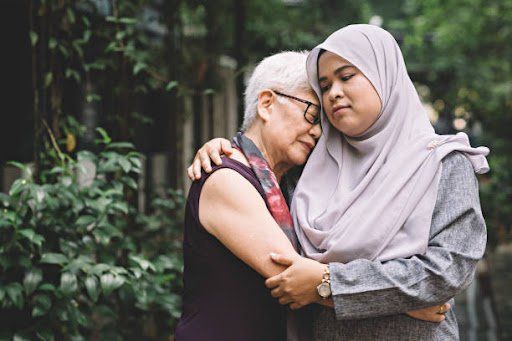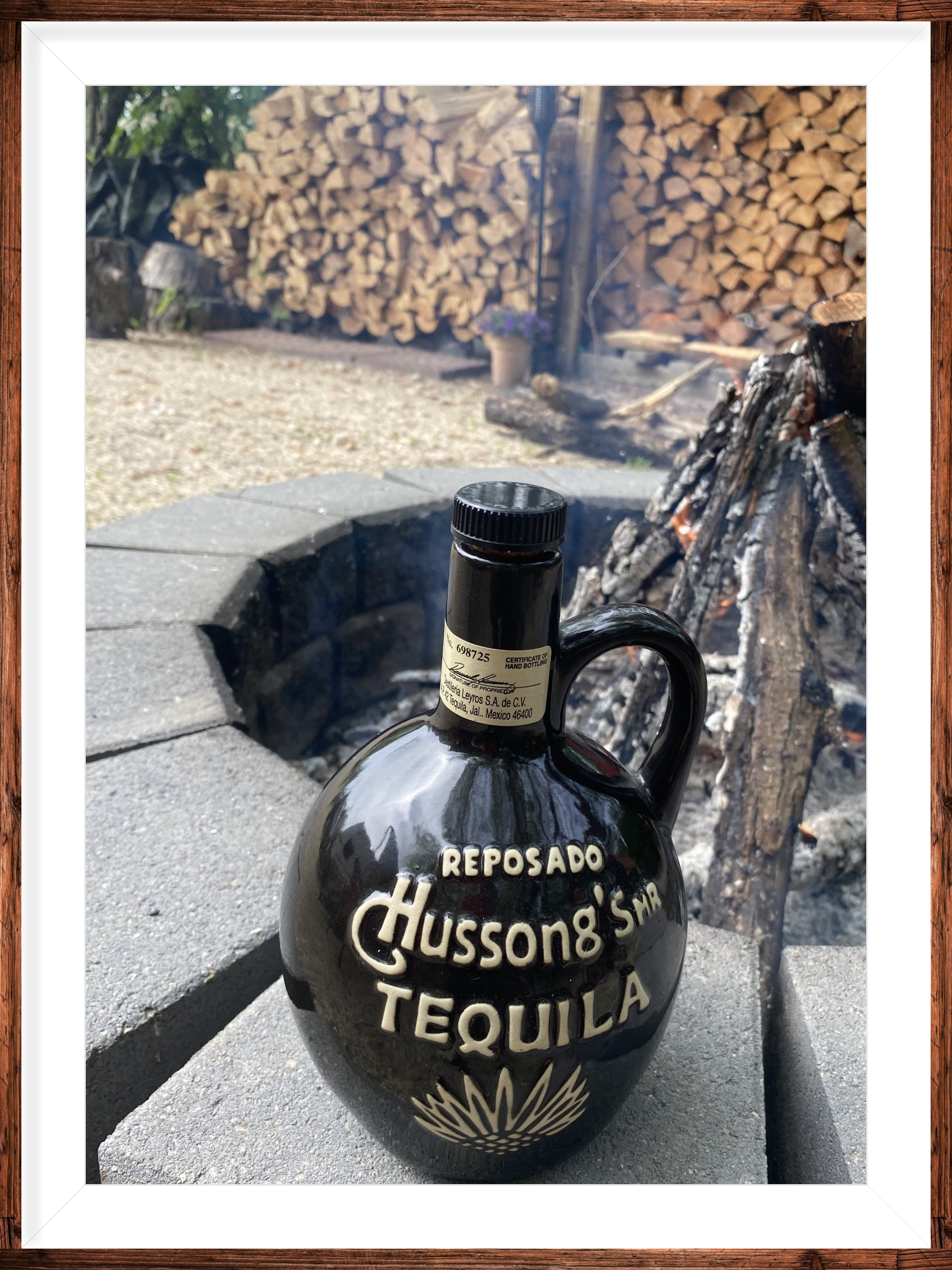Articles & Interviews
We are people that believe shared knowledge helps all of us.
Not only will you find funeral information here, but also interviews with people from across North America on a wide range of topics that include Green Burials, Aging In Place, the importance of understanding and managing your Digital Life, how to play a Kazoo and more...
Planning Ahead

In today's society, we tend to ignore death. We avoid discussing it, thinking about it, and planning for it. While we all know that death is inevitable, we are unwilling to think it will ever happen to us. "Death can be terrifying." Dr. Todd Kashdan opened his article, "Confronting Death with an Open, Mindful Attitude", with those four painfully-honest words. He goes on to explain why death is such a scary thing for most of us. "Recognizing that death is inescapable and unpredictable makes us incredibly vulnerable. This disrupts our instinct to remain a living, breathing organism." Our fear of dying has kept us alive (as individuals and communities) for centuries. It's natural. Yet, the fear of dying does not serve our personal need for safety and if we are to live our lives, we need to release the fear altogether. Dr. Kashdan argues that a mindful approach to living may be what's needed. What is Mindfulness? Mindfulness has been defined as, "The state of active, open attention on the present. When you're mindful, you observe your thoughts and feelings from a distance, without judging them good or bad. Instead of letting your life pass you by, mindfulness means living in the moment and awakening to experience." Awakening to the inevitability of your own death is liberating. You are no longer forced to manage the fear; you are able to include death into your life experience. Preparing for Your Death Death is a natural part of life. When you live with intention, which involves looking toward death and preparing for it, you crush its power to keep you from living fully. The following task list will, when done mindfully, help you to not only confront your own death but to take control of it. While you'll never actually know how your life will end until the time of your death, your preparations will help you become comfortable with it. Prepare a will , notarize it, and provide a copy to your executor as well as any other individuals who are important in the settlement of your estate. Designate a Power of Attorney and Living Will, two essential documents if you are ever unable to care for your financial, medical, or legal needs due to an accident or illness. Make a detailed plan of your funeral or memorial service, which will help your survivors acknowledge and celebrate your accomplishments. Organize all financial papers including insurance policies, bills, mortgage papers, vehicle titles, and loan documents. It may be useful to consider adding a trusted family member to your bank accounts. Secure your digital life for your survivors. Make sure to list all account passwords and usernames and let your survivors know how you would like your digital real estate (email and social media accounts) handled after your death. Sources: "What is Mindfulness?", Psychology Today, 2014 Kashdan, Todd, Ph.D., "Confronting Death with an Open, Mindful Attitude", Psychology Today, 2011 Klosowski, Thorin , "One Day You're Going to Die. Here's How to Prepare for It", 2013
Grieving

I certainly don't have the expertise in knowing how to speak about grieving. I do know a meaningful funeral event is a good beginning on the grief journey. I hope this information from reputable sources will be helpful in your journey. - Richard. After the unexpected death of his wife, author C.S. Lewis wrote in A Grief Observed, "No one ever told me that grief felt so like fear. The death of a beloved is an amputation." While dealing with grief is not easy, we believe the resources within this section of our website can help. Should you need additional support in grieving your loss, please call us. We will do everything we can to assist you. Grieving with Purpose No one is prepared for grief. The rush of feelings, thoughts, anxieties, and heartache can take us by surprise and drive us to our knees. Yet, when we choose to harness that power for self-growth, amazing things can happen. Good can come from pain. Sigmund Freud first brought up the concept of grief work in 1917, and today the idea that bereavement is purpose-driven continues. Dr. James Worden chose to see the work of bereavement as task-oriented: To accept the reality of the loss To process the pain of grief To adjust to a world without the deceased To find an enduring connection with the deceased while embarking on a new life Your current job is to focus your attention on achieving each of those goals. It will not occur in any logical order; each of us is different and the path we walk in the bereavement journey is not a straight one. Dealing with grief is hard work. It takes both courage and hard work to successfully adapt to the loss of a significant person in your life. Six Signposts Along Your Journey Dr. Stephen Joseph identifies what he calls six signposts to facilitate post-traumatic growth. He reminds readers too that "post-traumatic growth does not imply the absence of emotional distress and difficulties in living. It does imply that it is possible through the struggle to come out on the other side, stronger and more philosophical about life." Before identifying these six signposts, Dr. Joseph reminds his readers of three very important things: You are not on your own Trauma is a normal and natural process Growth is a journey He also provides a fundamental rule: don't do anything you might not be able to handle now. "If you experience intense emotions, become physically upset, or begin to panic... stop." He gently reminds readers that "having a sense of personal control over your recovery is important. There might be some things you do not feel ready to handle now, but in time, as you discover new strength and develop new coping skills, this will likely change." Signpost #1: Taking Stock Are you physically well? Are you getting enough sleep and eating the right foods for optimum health? Have you received the medical, legal, or psychological help you need? What is your current condition: physically, spiritually, and emotionally? Signpost #2: Harvesting Hope People traumatized by loss often feel hopeless. Find inspiration in the stories of personal growth written by others; set goals and practice hope as you set out to achieve them. Signpost #3: Re-Authoring Learn to tell your story differently. Take the victim mentality out of the story of loss and replace it with the survivor’s mentality to return to a sense of control over your life. Signpost #4: Identifying Change Keeping a daily diary can help you to see the small changes more easily. You can also track those moments when you feel at your best and identify the conditions that brought them about. Identify and nurture the positive changes in your life throughout your bereavement journey. Signpost #5: Valuing Change Review these changes and identify the ones that you'd like to continue nurturing. Personal transformation requires it. Growth is encouraged when we take time to think about what we have gained from loved ones and find a way to use what we have learned to give to others. Signpost #6: Expressing Change in Action Express your growth in new behaviours or more simply, put your growth into action. When you think in terms of concrete actions, it helps make the growth experienced within your bereavement real to you. "By focusing on these six signposts," writes Dr. Joseph, "you will find that your post-traumatic growth is beginning to take root." Ending Denial and Finding Acceptance Acceptance is the very first step in your bereavement. Dr. James Worden writes that we must "come full face with the reality that the person is dead, that the person is gone and will not return." This is where a funeral can be important. Traditionally, the casketed body of the deceased is at the front of the room and guests are invited to step up and personally say their goodbyes. Part of stepping up means seeing with our own eyes that death has occurred and actualizing is an essential part of coming to accept it. Yet, the traditional viewing has eroded over time with many families today choosing cremation and opting to hold a memorial service after the cremation has taken place. The focal point of the ceremony becomes the cremation urn, holding the cremated remains or ashes out of sight and making the reality of the death less evident and the road to acceptance less clearly marked. Acceptance May Seem Out of Reach For many, acceptance means agreeing to reality. Most of us, when we lose someone dear to us, simply don't want to agree to it; we have an aversion to agreeing and accepting. So, let's use a different word—try "adjustment", or "integration". Both words focus on the purposeful release of disbelief. Someone who has integrated the death of a loved one into their life has cleared the path to create a new life; a pro-active life where a loved one's memory is held dear, perhaps as a motivating force for change. It does take time. In "Coping with the Loss of a Loved One," the American Cancer Society cautions readers that "acceptance does not happen overnight. It’s common for it to take a year or longer to resolve the emotional and life changes that come with the death of a loved one. The pain may become less intense, but it’s normal to feel emotionally involved with the deceased for many years after their death. In time, the person should be able to reclaim the emotional energy that was invested in the relationship with the deceased, and use it in other relationships." Whatever you call it, this essential part of mourning is what allows us to live fully again. It allows us to step out of the darkness of mere existence and back into the sunshine where life is sweet again. Of course, it's a very different life than the one you had before your loved one died. Sources: Freud, Sigmund. On the History of the Psycho-Analytic Movement Papers on Metaphyschology and Other Works. Worden, James, Grief Counseling & Grief Therapy: A Handbook for the Mental Health Practitioner, 4th Edition, 2009. Fleming, Stephen. The Changing Face of Grief: From 'Going On to 'On-Going'' Joseph, Stephen. What Doesn't Kill Us: the New Psychology of Posttraumatic Growth American Cancer Society, "Coping with the Loss of a Loved One", 2012

In Disenfranchised Grief: New Directions, Challenges, and Strategies for Practice, Kenneth Doka offered a very simple definition of disenfranchised grief as an experience when "survivors are not accorded a right to grieve". Can others deny us our right to feel sorrow and pain? Can they set limits on our bereavement? The answer is, at least in some cases, yes. It happens all the time. In Disenfranchised Grief Revisited: Discounting Hope and Love, Dr. Thomas Attig claimed this right entitles a bereaved person to grieve when they need or choose to and in the manner in which they choose. In response, others are obligated to honour the right and refrain from interfering in the experiences and efforts of grieving. It's more than "a matter of indifference to the experiences and efforts of the bereaved. It is more actively negative and destructive as it involves denial of entitlement, interference, and even imposition of sanction. Disenfranchising messages actively discount, dismiss, disapprove, discourage, invalidate, and delegitimize the experiences and efforts of grieving. In this way, the people around the bereaved withhold permission, disallowing, constraining, hindering, and even prohibiting the survivor's mourning.” When Can Disenfranchised Grief Occur? Author Jonathan Vatner shares examples of situations where disenfranchised grief can result: Your ex-husband passes away, for example, and your friends don't see why it matters. An executive is having a serious affair with her married co-worker. When he dies unexpectedly, the expression of her grief is limited by the covert nature of the relationship. A spouse, brother, or son is missing in military action. When death has occurred due to socially unacceptable causes such as AIDS or suicide. A beloved dog, cat or other pet has died. What Does Disenfranchised Grief Sound Like? When you are mourning an unrecognized or undervalued loss, you may hear statements like this: "When things like this happen, all you can do is give it time and wait it out." "Eventually, you’ll get over this." "The best thing is to try to put what happened behind you and get back to normal as soon as possible. Try to go on as if nothing has changed." "There’s no point in looking for meaning in something like this. Suffering brings us face to face with absurdity. The best thing is to try to forget." "Face reality. She is dead. You will have to fill her place with something else." Sometimes those dealing with grief disenfranchise their grief with inner talk that sounds like this: "Somehow it feels disloyal to laugh or try to be happy. I sometimes feel that I owe it to him to live in sorrow." "What can I possibly have to look forward to?" "I’m kind of embarrassed to admit that in some ways, I seem to have grown from the death of my child." "How can I ever let myself love again if it all comes to this?" Suffer in Silence No More The stress of grieving in isolation can be unbearable. If we listen to Dr. Lani Leary, even if you endure the ups and downs of bereavement on your own, the grief work you do will still be compromised. She tells us that it is not time that heals. Instead, healing comes with validation: "All grief needs to be blessed. In order to be blessed, it must be heard. Someone must be present, someone who is willing to hold it by listening without judgment or comparison." In the article "Mourning Becomes Neglected: 4 Healthy Ways to Grieve," author Jonathan Vatner shares these four ways you can reclaim your right to grieve and get much-needed support: Recognize that there is nothing wrong with you. Whatever your feelings are, they're legitimate. Find people who will understand. Search online—there are bereavement support groups for just about any type of loss. Be honest about how you feel. If a well-meaning friend cracks a joke about your deceased ex-husband, explain that this loss is painful for you. Develop a ritual or ceremony to commemorate the person's passing. Visit the grave after the funeral or hold a private one when you can take as much time as you need to express your anguish. Speak Up and Speak Out In the book Invisible Monsters, author Chuck Palahniuk wrote, “Most times, it's just a lot easier not to let the world know what's wrong.” Whatever you do, if you feel those around you are not supportive of your bereavement, do not follow his words. Let others know how you feel and what you're thinking. In doing so, you're educating them on the essential truth of bereavement: all losses are worthy of recognition and acknowledgement and all those in mourning have the right to grieve. Sources: Doka, Kenneith, Disenfranchised Grief: New Directions, Challenges, and Strategies for Practice Attig, Thomas, Ph.D, "Disenfranchised Grief Revisited: Discounting Hope and Love" Vatner, Jonathan, "Mourning Becomes Neglected: 4 Healthy Ways to Grieve" Leary, Lani, Ph.D., "No One Has to Grieve Alone: Validation is the Key to Resolving Grief", 2012. Palahniuk, Chuck, Invisible Monsters

Sometimes it feels as if your bereavement will never end. You feel as if you’d give anything to have the pain go away; to have the long lonely hours between nightfall and dawn pass without heartache. You are not the only grieving person who has longed for some measure of relief. In the novel, My Sister’s Keeper, author Jodi Picoult wrote, “There should be a statute of limitations on grief. A rule book that says it is all right to wake up crying, but only for a month. That after 42 days you will no longer turn with your heart racing, certain you have heard her call out your name.” No such rule book exists. Grief counselors and therapists tell us that the length of time it takes anyone to grieve the loss of someone they held dear to them is dependent on the situation, how attached you were to the deceased, how they died, your age and gender. So many variables exist and there’s absolutely no way to predict how long it will take for you to adapt to your loss. The Difference Between Normal and Complicated Grief Research findings have led experts to many different categories of grief experience ranging from normal to complicated. Normal (or uncomplicated) grief has no timeline and encompasses a range of feelings and behaviors common after loss, such as bodily distress, guilt, hostility, preoccupation with the image of the deceased, and the inability to function as one had before the loss. All are normal and present us with profound and seemingly endless challenges. Yet, Katherine Walsh says, “Over the course of time, with average social support…most individuals will gradually experience a diminishment of these feelings, behaviors, and sensations.” So, how can you know if your bereavement is no longer within the range of normal? Ms. Walsh goes on to say, “While there is no definitive time period by which this happens, if an individual or members of a family continue to experience distress intensely or for a prolonged period—or even unexpectedly years after a loss—they may benefit from treatment for complicated grief.” A Useful Model for Assessment: Worden's Four Tasks of Mourning There are certain tasks when achieved during your bereavement that can successfully allow you to emerge on the other side of loss as a better, stronger and more resilient individual. James Worden proposed these four tasks: To accept the reality of the loss To process the pain of grief To adjust to a world without the deceased To find an enduring connection with the deceased while embarking on a new life Instead of focusing on your bodily discomforts, feelings, and common behaviors, this model allows you to see where you may be stuck or stalled in the adaptive process. Fortunately, Worden also gives us a list of indicators advising that "Any one of these clues in and of itself may not be sufficient," for a diagnosis of complicated grief. "However," he continues, "any of these…should be taken seriously, and the diagnosis of complicated grief should be considered when they appear." 12 Clues... 12 Insights While grief educators and theorists tell us that a diagnosis of complicated grief should not even be attempted until after the first anniversary of the death, if any one of the following symptomatic clues exists for longer than six months, you may want to consider grief counseling or grief therapy: You cannot speak of the deceased without experiencing intense and fresh grief long after the loss. A relatively minor event triggers an intense grief reaction. Your conversations with others are littered with references to loss. In other words, loss is an ever-present motif in your worldview. You have issues related to your loved one's possessions. Keeping everything the same as before their death could indicate trouble. Tossing out everything right away can also be a clue to disordered mourning. (You also need to factor in your cultural and religious background) You have developed physical symptoms similar to those of the deceased before their death. Sometimes these symptoms recur annually, on the anniversary of the death or holidays. Increased susceptibility to illness or the development of a chronic physical complaint can also be an indicator. If you have made radical changes to your lifestyle or excluded friends, family members, or even activities associated with the deceased, it may indicate unresolved grief. A long history of depression often marked by guilt or low self-esteem can reveal disordered mourning. The opposite is also true: a person experiencing a false sense of happiness or elation could be experiencing unresolved grief. A compulsion to imitate the deceased in personality or behavior can be a sign of complicated mourning. Having self-destructive impulses or exhibiting self-destructive behaviors can be significant. These can range from substance abuse, engaging in self-harm, developing eating disorders and suicidal tendencies. A sense of unexplained sadness occurring at certain times each year (holidays, anniversaries, or birthdays) can also be a clue to unresolved grief. Developing a strong fear about dying, especially when it relates to the illness that took the life of your loved one, is an important clue. If you have avoided visiting your loved one's grave or if you are still unwilling to discuss the circumstances of their death, this could indicate complications in your bereavement. There are many types of complicated grief; it can be delayed, masked, exaggerated, or chronic. Self-diagnosis is without purpose. A year after the death, if you feel your grief symptoms worsening, we advise that you seek a referral from your family physician for professional grief counseling or therapy. Sources: Walsh, Katherine, Grief and Loss: Theories and Skills for the Helping Professions, 2nd Edition, 2012. Worden, James, Grief Counseling & Grief Therapy: A Handbook for the Mental Health Practitioner, 4th Edition, 2009.
Funeral Arrangements

What to Expect Before the Funeral Event It's a common enough experience; a loved one dies and now you've got to face something you may have never done before; making their funeral arrangements. Now not only are you emotionally affected by their death, but you're also anxious and need to know what to expect when you arrive. We will do everything we can to make the experience as easy as possible. And it won't take as long as you think. Vital Statistics When it comes to properly completing the necessary paperwork for Vital Statistics and writing a detailed obituary, accuracy is everything. You'll need to bring as much of the following as you can: The deceased's full name and/or maiden name Their Social Insurance Number Deceased address Place of Birth Date of Birth Parent's names (maiden name of mother) and Places of Birth Marital status Spouses name, including maiden name Occupation and place of work Informant's name and address If you're unable to provide any of this information, you can always call us later to provide whatever is missing. Planning the Funeral Event Creating a meaningful Funeral Event to share the stories of your loved one is at the heart of what you'll be doing when we meet. So to make it easier, we ask that you bring: Pre-arrangement papers, if applicable A photograph of reasonably good quality Clothing for the deceased, if applicable Cemetery property information A list of preferred charities for memorial donations, if applicable A list of pallbearers, if applicable Desired musical and readings selections Thoughts on the food and beverages and amount need for the reception How long does this take? Usually about an hour, depending on the type of Funeral Event we are creating. What to Expect During the Funeral Event Will People Cry? Will they Laugh, or perhaps Applaud? People cry at many events that celebrate and stir emotions - weddings, baptisms and anniversaries, to name a few. The same happens at a funeral. People laugh at funeral events too. Dr. Seuss said, “Don't cry because it's over, smile because it happened.” Our lives are filled with so much. Laughter and joy are part of our stories. Standing up and giving a round of applause for a life well lived can be a wonderful tribute too. What to Expect After the Funeral Event The Early Days After Loss The funeral event is over, and things have begun to grow quiet. Maybe the phone isn't ringing as much as it was, or fewer people are stopping by to check in on you. Your loved one's death continues to become more of a reality. And the very thought of facing your life over the next few weeks and months may fill you with loneliness and a sense of dread. It all feels like way too much to deal with. It's okay to take care of yourself first: Eat well Exercise Plan each day with tasks to accomplish. As time goes by, a "New Normal" will slowly appear. You also need to spend time focused on completing the paperwork that will officially change the status of your loved one with banks and creditors, employers, insurance companies, and mortgage holders, etc. It is a slow and perhaps challenging process, so try to be patient and seek expert advice if you need it. The Paperwork It's time to get organized. Locate and safeguard as many of the documents listed below. It might be easier to put each into a designated set of file folders and keep them within easy reach: Birth certificate Driver's license Medical cards Passport (if applicable) Marriage certificate Divorce papers (if applicable) Deeds and Titles to real and personal property Veteran documentation Recent Income Tax Forms Social Insurance Card All Insurance documents: Life, Health, Automobile (there may be more than one policy in each category) 17 Things to Do After the Funeral Visit the Community Legal Education Association website for an Executor's Checklist. Or here's a shortlist of some things you need to do: Before you do anything, get a notebook to keep track of tasks, phone calls, people and contact information, etc. As you begin contacting the various agencies: Record date, time and people you talked to, their contact information and what tasks they will do and when. Record when tasks are completed or followed-up if past anticipated dates. Request the Provincial Death Certificate from the funeral home and determine how many you will need. Request the Funeral Director's Statement of Death and determine how many you will need. Many agencies will accept this document rather than the Provincial Death Certificate. Check to see if the deceased had left a will. It may require contacting the family attorney, checking your safe deposit box or home safe. Get the mail redirected, if applicable. Visit the Canada Post website to learn more about how to submit a Change of Address form. Or stop by your local post office. Stop health insurance coverage. You may need to provide them with additional information, so keep your relevant paperwork handy. Contact employer or union. Determine if there are any death-related benefits available, ask (and answer) questions, and change any relevant contact information. Make sure to pay or arrange to pay previous bills, including all utilities. Speak to their representatives to advise of the death and their procedures to make payments or close accounts. Initiate probate of the Will. If you don't have one, you may want to find and hire a lawyer for this process. Transfer title of real and personal property. Whether it's an automobile, boat, motorcycle, RV, or plane, you'll need to inform the appropriate agency. Also, notify any related vehicular or personal property insurance companies of the change in status. Close or modify credit card accounts. You will probably need to provide each of them with a copy of the death certificate. Again, keep that set of file folders handy. Contact life insurance companies. Not everyone has life insurance, but some people have more than one policy. No matter how many policies were in force, you will probably need to provide each of them with a certified copy of the death certificate for each claim made. Notify other policyholders of the change in "Beneficiary" status. If your loved one was a designated beneficiary on the insurance policies, investment or banking accounts of other individuals, then you'll need to notify them of the death of a beneficiary. Arrange to close or modify bank accounts. Depending on your relationship with the deceased, you may be entitled to convert it into your name. Change stocks and bonds into your name. Again, this depends on your relationship status with the deceased. To do this, you'll need to provide a copy of the death certificate to all organizations involved. Report the death to other agencies. It can include fraternal or business or professional organizations, gym and golf course memberships — to name a few. Tend to their digital estate. You'll need to inform the specific Social Media networking sites of the change in status. You will need to close email accounts as well as any online banking portal or investment accounts. Do You Have Any Questions? Just call . We'll do our best to help you.

It's interesting; funerals and celebrations of life have much in common, yet they often appear very different. Each is a ceremony, a gathering of people who share a common loss. It's just that one is more rooted in tradition, while the other is the result of recent changes in social values. But both serve to do three things: Help the bereaved family and their community publicly acknowledge the death of one of their own Support the grieving family by surrounding them with caring friends, co-workers, and neighbors Move the deceased from one social status to another Yet, they achieve those things in very different ways. First, let's take a closer look at what most of us commonly see as very traditional funerals. The Funeral It's not surprising funerals have been around for a very long time. Composed of three activities, the visitation, the funeral service, and the committal service, performed at the graveside - this funeral is the one we'd easily recognize from contemporary literature and film. The Visitation Held before the funeral, often the night before, but sometimes on the same day, the visitation (or viewing) is when people come to support the family and, more importantly, pay their respects to the deceased. This often involves stepping up to the casket to view the body; either in the company of a member of the surviving family or on your own. The Funeral Service Commonly held in the funeral home or church, the traditional funeral service is led by an officiant of one kind or another (most commonly a pastor or the funeral director). This individual follows a very predictable funeral order of service which includes the singing of hymns, and invocations, Bible recitations, Scripture readings, and prayers led by the officiant. The Committal Service It takes place at the cemetery, after a slow and respectful automobile procession from where the funeral was held. The committal service ends when the casketed remains are lowered into the ground, and final prayers are said. Celebrations of Life Author Barbara Kingsolver, in her book The Poisonwood Bible, wrote “To live is to be marked. To live is to change, to acquire the words of a story, and that is the only celebration we mortals really know.” We think this reflection is at the heart of a celebration of life . While a funeral, as we've described above, has more to do with the orderly and often spiritually defined, a celebration of life is more concerned with telling the story of the deceased. Celebrations of life are just that: a time when people come together more to celebrate the unique personality and achievements of the deceased than to merely witness or mark the change in their social status. Celebrations of life are similar to memorial services , which can be described as a hybrid event, combining the flexibility of a celebration of life with many activities of a traditional funeral order-of-service. There's more room for creativity in a celebration of life than a funeral. Since celebrations of life are commonly held after the individual's physical remains have been cared for through burial or cremation, there is much more time available to plan the event. And without doubt, this allows you to make better decisions about how you'd like to celebrate the life of someone you dearly loved. Are You Undecided? Turn to Us. We've got years of experience listening, brainstorming, and advising families how to best pay tribute to a beloved family member. That means we're the perfect people to help you decide between a funeral and a celebration of life. We'll explore your funeral service options with you in detail, taking all the time you need. In the book Chocolat, by Joanne Harris, you'll find this fundamental truth: “Life is what you celebrate. All of it. Even its end.” As funeral professionals, we help families express reverence for life. Let us do that for your family. Call our funeral home to speak with a member of our staff. Sources: Barbara Kingsolover, The Poisonwood Bible Joanne Harris, Chocolat
Cremation

My last blog discussed what you could do with Cremated Remains. We now travel together and consider Scattering Gardens. Over the past few decades, several Winnipeg Churches have developed Scattering Gardens. In many rural Manitoba communities, the cemetery is an integral part of the church. A few Winnipeg churches are located on, or own cemeteries too. Several cemeteries have included Scattering Gardens also. To scatter Cremated Remains, means they return to Mother Earth with no urn. Most churches that have a garden provide an urn that can be given to the funeral home to place your person temporarily. The church keeps a record of the scattering. Most have an interment fee, and may only be available to members of the church. Cemeteries that offer Scattering Gardens may not provide a temporary urn. Record keeping and fees apply here too. It's important to note that the Cremation is the disposition registered with Manitoba's Vital Statistics office. Make sure you or your family keep a record of the scattering, so future generations know where and when it took place. Next time - Do you need an urn?
Burial & Cemetery

My last blog discussed what you could do with Cremated Remains. We now travel together and consider Scattering Gardens. Over the past few decades, several Winnipeg Churches have developed Scattering Gardens. In many rural Manitoba communities, the cemetery is an integral part of the church. A few Winnipeg churches are located on, or own cemeteries too. Several cemeteries have included Scattering Gardens also. To scatter Cremated Remains, means they return to Mother Earth with no urn. Most churches that have a garden provide an urn that can be given to the funeral home to place your person temporarily. The church keeps a record of the scattering. Most have an interment fee, and may only be available to members of the church. Cemeteries that offer Scattering Gardens may not provide a temporary urn. Record keeping and fees apply here too. It's important to note that the Cremation is the disposition registered with Manitoba's Vital Statistics office. Make sure you or your family keep a record of the scattering, so future generations know where and when it took place. Next time - Do you need an urn?

Yes, you can get a biodegradable casket in Winnipeg. The growing popularity of green or natural burials has made it easier to purchase biodegradable caskets. You can buy them online or through a funeral director like me. You can also make them yourself if you’d like. The most popular biodegradable or green caskets are made of cardboard. These will break down and decompose naturally along with the body they carry. You can also purchase caskets woven from eco-friendly materials such as bamboo or willow. Simple wood caskets (the ‘pine box’) are also good options for some families. They can be purchased. I’ve also seen people make them at home completely out of biodegradable materials. When a family requests an eco-friendly burial, we will walk them through their options and how to look after all the details. Sometimes families want a funeral director like me to look after everything for them and I’m happy to do that. Other times, they prefer to look after many of the details themselves. In those cases, I’m on hand to provide advice and help them through the process. We answer questions about funerals in this space regularly. If you have a question about funerals, cremations or burials in Winnipeg or Manitoba, please email me at richard@richardrosin.ca .
When Death Occurs

In today's society, we tend to ignore death. We avoid discussing it, thinking about it, and planning for it. While we all know that death is inevitable, we are unwilling to think it will ever happen to us. "Death can be terrifying." Dr. Todd Kashdan opened his article, "Confronting Death with an Open, Mindful Attitude", with those four painfully-honest words. He goes on to explain why death is such a scary thing for most of us. "Recognizing that death is inescapable and unpredictable makes us incredibly vulnerable. This disrupts our instinct to remain a living, breathing organism." Our fear of dying has kept us alive (as individuals and communities) for centuries. It's natural. Yet, the fear of dying does not serve our personal need for safety and if we are to live our lives, we need to release the fear altogether. Dr. Kashdan argues that a mindful approach to living may be what's needed. What is Mindfulness? Mindfulness has been defined as, "The state of active, open attention on the present. When you're mindful, you observe your thoughts and feelings from a distance, without judging them good or bad. Instead of letting your life pass you by, mindfulness means living in the moment and awakening to experience." Awakening to the inevitability of your own death is liberating. You are no longer forced to manage the fear; you are able to include death into your life experience. Preparing for Your Death Death is a natural part of life. When you live with intention, which involves looking toward death and preparing for it, you crush its power to keep you from living fully. The following task list will, when done mindfully, help you to not only confront your own death but to take control of it. While you'll never actually know how your life will end until the time of your death, your preparations will help you become comfortable with it. Prepare a will , notarize it, and provide a copy to your executor as well as any other individuals who are important in the settlement of your estate. Designate a Power of Attorney and Living Will, two essential documents if you are ever unable to care for your financial, medical, or legal needs due to an accident or illness. Make a detailed plan of your funeral or memorial service, which will help your survivors acknowledge and celebrate your accomplishments. Organize all financial papers including insurance policies, bills, mortgage papers, vehicle titles, and loan documents. It may be useful to consider adding a trusted family member to your bank accounts. Secure your digital life for your survivors. Make sure to list all account passwords and usernames and let your survivors know how you would like your digital real estate (email and social media accounts) handled after your death. Sources: "What is Mindfulness?", Psychology Today, 2014 Kashdan, Todd, Ph.D., "Confronting Death with an Open, Mindful Attitude", Psychology Today, 2011 Klosowski, Thorin , "One Day You're Going to Die. Here's How to Prepare for It", 2013

I certainly don't have the expertise in knowing how to speak about grieving. I do know a meaningful funeral event is a good beginning on the grief journey. I hope this information from reputable sources will be helpful in your journey. - Richard. After the unexpected death of his wife, author C.S. Lewis wrote in A Grief Observed, "No one ever told me that grief felt so like fear. The death of a beloved is an amputation." While dealing with grief is not easy, we believe the resources within this section of our website can help. Should you need additional support in grieving your loss, please call us. We will do everything we can to assist you. Grieving with Purpose No one is prepared for grief. The rush of feelings, thoughts, anxieties, and heartache can take us by surprise and drive us to our knees. Yet, when we choose to harness that power for self-growth, amazing things can happen. Good can come from pain. Sigmund Freud first brought up the concept of grief work in 1917, and today the idea that bereavement is purpose-driven continues. Dr. James Worden chose to see the work of bereavement as task-oriented: To accept the reality of the loss To process the pain of grief To adjust to a world without the deceased To find an enduring connection with the deceased while embarking on a new life Your current job is to focus your attention on achieving each of those goals. It will not occur in any logical order; each of us is different and the path we walk in the bereavement journey is not a straight one. Dealing with grief is hard work. It takes both courage and hard work to successfully adapt to the loss of a significant person in your life. Six Signposts Along Your Journey Dr. Stephen Joseph identifies what he calls six signposts to facilitate post-traumatic growth. He reminds readers too that "post-traumatic growth does not imply the absence of emotional distress and difficulties in living. It does imply that it is possible through the struggle to come out on the other side, stronger and more philosophical about life." Before identifying these six signposts, Dr. Joseph reminds his readers of three very important things: You are not on your own Trauma is a normal and natural process Growth is a journey He also provides a fundamental rule: don't do anything you might not be able to handle now. "If you experience intense emotions, become physically upset, or begin to panic... stop." He gently reminds readers that "having a sense of personal control over your recovery is important. There might be some things you do not feel ready to handle now, but in time, as you discover new strength and develop new coping skills, this will likely change." Signpost #1: Taking Stock Are you physically well? Are you getting enough sleep and eating the right foods for optimum health? Have you received the medical, legal, or psychological help you need? What is your current condition: physically, spiritually, and emotionally? Signpost #2: Harvesting Hope People traumatized by loss often feel hopeless. Find inspiration in the stories of personal growth written by others; set goals and practice hope as you set out to achieve them. Signpost #3: Re-Authoring Learn to tell your story differently. Take the victim mentality out of the story of loss and replace it with the survivor’s mentality to return to a sense of control over your life. Signpost #4: Identifying Change Keeping a daily diary can help you to see the small changes more easily. You can also track those moments when you feel at your best and identify the conditions that brought them about. Identify and nurture the positive changes in your life throughout your bereavement journey. Signpost #5: Valuing Change Review these changes and identify the ones that you'd like to continue nurturing. Personal transformation requires it. Growth is encouraged when we take time to think about what we have gained from loved ones and find a way to use what we have learned to give to others. Signpost #6: Expressing Change in Action Express your growth in new behaviours or more simply, put your growth into action. When you think in terms of concrete actions, it helps make the growth experienced within your bereavement real to you. "By focusing on these six signposts," writes Dr. Joseph, "you will find that your post-traumatic growth is beginning to take root." Ending Denial and Finding Acceptance Acceptance is the very first step in your bereavement. Dr. James Worden writes that we must "come full face with the reality that the person is dead, that the person is gone and will not return." This is where a funeral can be important. Traditionally, the casketed body of the deceased is at the front of the room and guests are invited to step up and personally say their goodbyes. Part of stepping up means seeing with our own eyes that death has occurred and actualizing is an essential part of coming to accept it. Yet, the traditional viewing has eroded over time with many families today choosing cremation and opting to hold a memorial service after the cremation has taken place. The focal point of the ceremony becomes the cremation urn, holding the cremated remains or ashes out of sight and making the reality of the death less evident and the road to acceptance less clearly marked. Acceptance May Seem Out of Reach For many, acceptance means agreeing to reality. Most of us, when we lose someone dear to us, simply don't want to agree to it; we have an aversion to agreeing and accepting. So, let's use a different word—try "adjustment", or "integration". Both words focus on the purposeful release of disbelief. Someone who has integrated the death of a loved one into their life has cleared the path to create a new life; a pro-active life where a loved one's memory is held dear, perhaps as a motivating force for change. It does take time. In "Coping with the Loss of a Loved One," the American Cancer Society cautions readers that "acceptance does not happen overnight. It’s common for it to take a year or longer to resolve the emotional and life changes that come with the death of a loved one. The pain may become less intense, but it’s normal to feel emotionally involved with the deceased for many years after their death. In time, the person should be able to reclaim the emotional energy that was invested in the relationship with the deceased, and use it in other relationships." Whatever you call it, this essential part of mourning is what allows us to live fully again. It allows us to step out of the darkness of mere existence and back into the sunshine where life is sweet again. Of course, it's a very different life than the one you had before your loved one died. Sources: Freud, Sigmund. On the History of the Psycho-Analytic Movement Papers on Metaphyschology and Other Works. Worden, James, Grief Counseling & Grief Therapy: A Handbook for the Mental Health Practitioner, 4th Edition, 2009. Fleming, Stephen. The Changing Face of Grief: From 'Going On to 'On-Going'' Joseph, Stephen. What Doesn't Kill Us: the New Psychology of Posttraumatic Growth American Cancer Society, "Coping with the Loss of a Loved One", 2012

In Disenfranchised Grief: New Directions, Challenges, and Strategies for Practice, Kenneth Doka offered a very simple definition of disenfranchised grief as an experience when "survivors are not accorded a right to grieve". Can others deny us our right to feel sorrow and pain? Can they set limits on our bereavement? The answer is, at least in some cases, yes. It happens all the time. In Disenfranchised Grief Revisited: Discounting Hope and Love, Dr. Thomas Attig claimed this right entitles a bereaved person to grieve when they need or choose to and in the manner in which they choose. In response, others are obligated to honour the right and refrain from interfering in the experiences and efforts of grieving. It's more than "a matter of indifference to the experiences and efforts of the bereaved. It is more actively negative and destructive as it involves denial of entitlement, interference, and even imposition of sanction. Disenfranchising messages actively discount, dismiss, disapprove, discourage, invalidate, and delegitimize the experiences and efforts of grieving. In this way, the people around the bereaved withhold permission, disallowing, constraining, hindering, and even prohibiting the survivor's mourning.” When Can Disenfranchised Grief Occur? Author Jonathan Vatner shares examples of situations where disenfranchised grief can result: Your ex-husband passes away, for example, and your friends don't see why it matters. An executive is having a serious affair with her married co-worker. When he dies unexpectedly, the expression of her grief is limited by the covert nature of the relationship. A spouse, brother, or son is missing in military action. When death has occurred due to socially unacceptable causes such as AIDS or suicide. A beloved dog, cat or other pet has died. What Does Disenfranchised Grief Sound Like? When you are mourning an unrecognized or undervalued loss, you may hear statements like this: "When things like this happen, all you can do is give it time and wait it out." "Eventually, you’ll get over this." "The best thing is to try to put what happened behind you and get back to normal as soon as possible. Try to go on as if nothing has changed." "There’s no point in looking for meaning in something like this. Suffering brings us face to face with absurdity. The best thing is to try to forget." "Face reality. She is dead. You will have to fill her place with something else." Sometimes those dealing with grief disenfranchise their grief with inner talk that sounds like this: "Somehow it feels disloyal to laugh or try to be happy. I sometimes feel that I owe it to him to live in sorrow." "What can I possibly have to look forward to?" "I’m kind of embarrassed to admit that in some ways, I seem to have grown from the death of my child." "How can I ever let myself love again if it all comes to this?" Suffer in Silence No More The stress of grieving in isolation can be unbearable. If we listen to Dr. Lani Leary, even if you endure the ups and downs of bereavement on your own, the grief work you do will still be compromised. She tells us that it is not time that heals. Instead, healing comes with validation: "All grief needs to be blessed. In order to be blessed, it must be heard. Someone must be present, someone who is willing to hold it by listening without judgment or comparison." In the article "Mourning Becomes Neglected: 4 Healthy Ways to Grieve," author Jonathan Vatner shares these four ways you can reclaim your right to grieve and get much-needed support: Recognize that there is nothing wrong with you. Whatever your feelings are, they're legitimate. Find people who will understand. Search online—there are bereavement support groups for just about any type of loss. Be honest about how you feel. If a well-meaning friend cracks a joke about your deceased ex-husband, explain that this loss is painful for you. Develop a ritual or ceremony to commemorate the person's passing. Visit the grave after the funeral or hold a private one when you can take as much time as you need to express your anguish. Speak Up and Speak Out In the book Invisible Monsters, author Chuck Palahniuk wrote, “Most times, it's just a lot easier not to let the world know what's wrong.” Whatever you do, if you feel those around you are not supportive of your bereavement, do not follow his words. Let others know how you feel and what you're thinking. In doing so, you're educating them on the essential truth of bereavement: all losses are worthy of recognition and acknowledgement and all those in mourning have the right to grieve. Sources: Doka, Kenneith, Disenfranchised Grief: New Directions, Challenges, and Strategies for Practice Attig, Thomas, Ph.D, "Disenfranchised Grief Revisited: Discounting Hope and Love" Vatner, Jonathan, "Mourning Becomes Neglected: 4 Healthy Ways to Grieve" Leary, Lani, Ph.D., "No One Has to Grieve Alone: Validation is the Key to Resolving Grief", 2012. Palahniuk, Chuck, Invisible Monsters
Natural Green Burials

Yes, you can get a biodegradable casket in Winnipeg. The growing popularity of green or natural burials has made it easier to purchase biodegradable caskets. You can buy them online or through a funeral director like me. You can also make them yourself if you’d like. The most popular biodegradable or green caskets are made of cardboard. These will break down and decompose naturally along with the body they carry. You can also purchase caskets woven from eco-friendly materials such as bamboo or willow. Simple wood caskets (the ‘pine box’) are also good options for some families. They can be purchased. I’ve also seen people make them at home completely out of biodegradable materials. When a family requests an eco-friendly burial, we will walk them through their options and how to look after all the details. Sometimes families want a funeral director like me to look after everything for them and I’m happy to do that. Other times, they prefer to look after many of the details themselves. In those cases, I’m on hand to provide advice and help them through the process. We answer questions about funerals in this space regularly. If you have a question about funerals, cremations or burials in Winnipeg or Manitoba, please email me at richard@richardrosin.ca .

Many people ask me if green funerals are allowed in Manitoba. The answer is yes. Some people may call them eco-funerals or natural burials. They’re becoming increasingly popular alternatives for families who want to have a simpler, green option for saying goodbye to their loved one. Green funerals aren’t new. In fact, they’re a very old tradition. Before we had a modern funeral industry, families took care of their dead themselves. When we’re asked about offering a green or natural burial, one of the first questions we must ask is if the family wishes to keep the deceased in their home? If so, we will advise them on what to do. They must keep the deceased dry and cool. Some families like to hang black crepe ribbons beside their front door as a sign that the family is in mourning. Family, friends and neighbours can come by to bring their love and comfort to the grieving family. You can invite your clergy to come to the house as well. Some families who choose a green burial in this fashion say that looking after a dead family member helps them absorb and accept the death more quickly and more fully. It can be a profound experience to say goodbye to a family member in this way. You don’t have to keep the deceased at home. We can arrange to move the deceased to another location in preparation for burial.
Digital Assets

The role of an Executor and Power of Attorney has become more diverse when we consider that in a digital age, much of our lives are unseen. We must consider our digital assets when drafting our Will. If you'd like to receive more information on this important part of our lives, please contact me and I'll email it to you. It is a 13-page booklet that covers virtually every type of asset you may have. Gratitude and acknowledgement go to STEP (The Society of Trustees and Estate Planners) for producing this publication. What is a digital asset? Examples that did not exist thirty years ago: Photo and video apps Social media Passwords Financial records Email accounts Cloud storage Smart home products Smartphones Tablets & wearables Cryptocurrency Movies E-books Streaming services Medical records Online games We tend to forget our digital assets because they are out of sight. They need to be included when drafting your Will to help your Executor or Power of Attorney know what you have and what to do with them.

As Manitobans and Canadians, we all have much more time on our hands as we stay in our Winnipeg homes and keep ourselves safe from the C-19 virus. It’s giving us a unique opportunity to take stock and perhaps refocus our lives to become more positive and fulfilling. One thing that most of us haven’t considered is our Digital Assets. Just like golf clubs or dishes, they are part of our lives, but are unseen yet need protecting. A Digital Asset is any device, App or service we use to manage our online lives. Examples are: Cloud services Subscriptions to Netflix, Apple TV, etc. Photo editing and file sharing Apps E-mail and Banking E-Commerce such as Amazon, Kijiji, and Skip the Dishes. Cryptocurrency accounts. E-Revenues from published books, advertising or commissions. Social Media Accounts (Facebook, LinkeIn, Twitter, etc) I'm curious - how many of you have received a Facebook notification telling you of a friend's birthday, knowing they died a while ago? It only takes a few minutes to update IF your Executor knows, and has access. Now is the time to inventory your Digital Assets; including all their user names and passwords. Doing this now will save your Power of Attorney and Executor a lot of headaches. Yes - they need to know about this too. And yes, you should be updating your Will to include your Digital Assets. There's an inventory booklet available as a PDF, provided by STEP (The Society of Trustees and Estate Planners) Click HERE and you'll go to the page on my site.
Condolences

I certainly don't have the expertise in knowing how to speak about grieving. I do know a meaningful funeral event is a good beginning on the grief journey. I hope this information from reputable sources will be helpful in your journey. - Richard. After the unexpected death of his wife, author C.S. Lewis wrote in A Grief Observed, "No one ever told me that grief felt so like fear. The death of a beloved is an amputation." While dealing with grief is not easy, we believe the resources within this section of our website can help. Should you need additional support in grieving your loss, please call us. We will do everything we can to assist you. Grieving with Purpose No one is prepared for grief. The rush of feelings, thoughts, anxieties, and heartache can take us by surprise and drive us to our knees. Yet, when we choose to harness that power for self-growth, amazing things can happen. Good can come from pain. Sigmund Freud first brought up the concept of grief work in 1917, and today the idea that bereavement is purpose-driven continues. Dr. James Worden chose to see the work of bereavement as task-oriented: To accept the reality of the loss To process the pain of grief To adjust to a world without the deceased To find an enduring connection with the deceased while embarking on a new life Your current job is to focus your attention on achieving each of those goals. It will not occur in any logical order; each of us is different and the path we walk in the bereavement journey is not a straight one. Dealing with grief is hard work. It takes both courage and hard work to successfully adapt to the loss of a significant person in your life. Six Signposts Along Your Journey Dr. Stephen Joseph identifies what he calls six signposts to facilitate post-traumatic growth. He reminds readers too that "post-traumatic growth does not imply the absence of emotional distress and difficulties in living. It does imply that it is possible through the struggle to come out on the other side, stronger and more philosophical about life." Before identifying these six signposts, Dr. Joseph reminds his readers of three very important things: You are not on your own Trauma is a normal and natural process Growth is a journey He also provides a fundamental rule: don't do anything you might not be able to handle now. "If you experience intense emotions, become physically upset, or begin to panic... stop." He gently reminds readers that "having a sense of personal control over your recovery is important. There might be some things you do not feel ready to handle now, but in time, as you discover new strength and develop new coping skills, this will likely change." Signpost #1: Taking Stock Are you physically well? Are you getting enough sleep and eating the right foods for optimum health? Have you received the medical, legal, or psychological help you need? What is your current condition: physically, spiritually, and emotionally? Signpost #2: Harvesting Hope People traumatized by loss often feel hopeless. Find inspiration in the stories of personal growth written by others; set goals and practice hope as you set out to achieve them. Signpost #3: Re-Authoring Learn to tell your story differently. Take the victim mentality out of the story of loss and replace it with the survivor’s mentality to return to a sense of control over your life. Signpost #4: Identifying Change Keeping a daily diary can help you to see the small changes more easily. You can also track those moments when you feel at your best and identify the conditions that brought them about. Identify and nurture the positive changes in your life throughout your bereavement journey. Signpost #5: Valuing Change Review these changes and identify the ones that you'd like to continue nurturing. Personal transformation requires it. Growth is encouraged when we take time to think about what we have gained from loved ones and find a way to use what we have learned to give to others. Signpost #6: Expressing Change in Action Express your growth in new behaviours or more simply, put your growth into action. When you think in terms of concrete actions, it helps make the growth experienced within your bereavement real to you. "By focusing on these six signposts," writes Dr. Joseph, "you will find that your post-traumatic growth is beginning to take root." Ending Denial and Finding Acceptance Acceptance is the very first step in your bereavement. Dr. James Worden writes that we must "come full face with the reality that the person is dead, that the person is gone and will not return." This is where a funeral can be important. Traditionally, the casketed body of the deceased is at the front of the room and guests are invited to step up and personally say their goodbyes. Part of stepping up means seeing with our own eyes that death has occurred and actualizing is an essential part of coming to accept it. Yet, the traditional viewing has eroded over time with many families today choosing cremation and opting to hold a memorial service after the cremation has taken place. The focal point of the ceremony becomes the cremation urn, holding the cremated remains or ashes out of sight and making the reality of the death less evident and the road to acceptance less clearly marked. Acceptance May Seem Out of Reach For many, acceptance means agreeing to reality. Most of us, when we lose someone dear to us, simply don't want to agree to it; we have an aversion to agreeing and accepting. So, let's use a different word—try "adjustment", or "integration". Both words focus on the purposeful release of disbelief. Someone who has integrated the death of a loved one into their life has cleared the path to create a new life; a pro-active life where a loved one's memory is held dear, perhaps as a motivating force for change. It does take time. In "Coping with the Loss of a Loved One," the American Cancer Society cautions readers that "acceptance does not happen overnight. It’s common for it to take a year or longer to resolve the emotional and life changes that come with the death of a loved one. The pain may become less intense, but it’s normal to feel emotionally involved with the deceased for many years after their death. In time, the person should be able to reclaim the emotional energy that was invested in the relationship with the deceased, and use it in other relationships." Whatever you call it, this essential part of mourning is what allows us to live fully again. It allows us to step out of the darkness of mere existence and back into the sunshine where life is sweet again. Of course, it's a very different life than the one you had before your loved one died. Sources: Freud, Sigmund. On the History of the Psycho-Analytic Movement Papers on Metaphyschology and Other Works. Worden, James, Grief Counseling & Grief Therapy: A Handbook for the Mental Health Practitioner, 4th Edition, 2009. Fleming, Stephen. The Changing Face of Grief: From 'Going On to 'On-Going'' Joseph, Stephen. What Doesn't Kill Us: the New Psychology of Posttraumatic Growth American Cancer Society, "Coping with the Loss of a Loved One", 2012

People can be very supportive in the initial days after a death. There are lots of things for them to do: help to make funeral arrangements, notify other friends and family of the death, and take care of day-to-day chores. It's a matter of being friends: taking on the necessary tasks, so survivors have the time and energy to actively mourn their loss. Unfortunately, once the funeral is over, things can change dramatically. This support system can dissolve as people return to their routines. The phone stops ringing and the bereaved may find their days and nights to be long and lonely. How to Help Someone in Mourning It's about not walking away. Granted, you may part company after the funeral, but a true ally doesn't stay away long; a good ally keeps checking in with the bereaved. Being a friend in need during this time can feel very difficult. Rachael Naomi Remen, M.D, wrote what she considers to be the focus of this grief work: "Grieving allows us to heal, to remember with love rather than pain. It is a sorting process. One by one you let go of things that are gone and you mourn for them. One by one you take hold of the things that have become a part of who you are and build again." You do that with a model of task-oriented bereavement. The Four Tasks of Mourning James Worden writes that the four things that must be completed to adjust with the death of a significant other are: To accept the reality of the loss To process the pain of grief To adjust to a world without the deceased To find an enduring connection with the deceased while embarking on a new life Those four tasks define the work of grieving. When you choose to become an ally to someone in mourning, it becomes your responsibility to support them in achieving those things within their time frame—not yours. In no way should you impose a limit on the amount of time their bereavement takes; the only limitations you can set have to do with any negative behaviors you witness. Is your friend using alcohol or drugs to manage their emotions? Are their eating habits becoming destructive? Are they choosing to isolate themselves from the world? All those things should raise red flags. If you think their grief has overwhelmed them and set them upon a self-destructive course, it may be time to suggest they see a certified grief counselor or therapist. Other meaningful things you can do to help them successfully adapt to their loss—again using Worden's four tasks as our guide—include: Attending their loved one's funeral is just the first step in accepting the reality of the loss. Taking them to visit their loved one's grave or other places of interment to leave flowers or spend time in conversation and contemplation continues this process. Never force them to go; only suggest and then support them when they agree to your suggestion. Empathetic listening—listening not just with your ears but with your heart. It goes a long way in helping them to process the pain of grief. Be willing. They will have to learn to be functional in this new world without their loved ones. That can involve practical assistance from you: help pay the bills, assist with grocery shopping, or offer your support while they learn or relearn how to do something. The bereaved must reintegrate their sense of self while at the same time process any changes in their beliefs, values, and assumptions about the world. Again, empathetic listening without judgment gives them a safe space to work out these significant changes in their worldview. Help them to find a suitable place in their emotional life for the deceased: "A place that is important but that leaves room for others" and "a place that will enable them to go on living effectively in the world.” It is suggested that they envision what they would want for themselves if their grief were magically removed. Writer Barbara Kingsolver penned these wise words about friendship: “The friend who holds your hand and says the wrong thing is made of dearer stuff than the one who stays away.” She's so right – never stay away because you're frightened of saying something inappropriate. In Coping with the Loss of a Loved One, The American Cancer Society said it best: "Be there. Even if you don't know what to say, just having someone near can be very comforting." Other simple tips include these: Ask how the bereaved person feels and listen to the answer. Don’t assume you know how they will feel on any given day. Listen and give support but don’t try to force someone if they’re not ready to talk. Accept whatever feelings the person expresses. If you can’t imagine feeling like they do, never tell them how they should or shouldn’t feel. Give reassurance without minimizing the loss. Try to have empathy with the person without assuming you know how they feel. Author Sarah Dessen captured the nature of good listening in this passage from her book, Just Listen: “This is the problem with dealing with someone who is actually a good listener. They don’t jump in on your sentences, saving you from actually finishing them or talk over you; allowing what you do manage to get out to be lost or altered in transit. Instead they wait, so you have to keep going.” So, as an ally to your bereaved friend or family member, you need to cultivate patience and the willingness to wait. Be watchful for signs of depression, which may include continuing thoughts of worthlessness or hopelessness, being unable to perform day-to-day activities, feelings of intense guilt, extreme weight loss and thoughts of death or suicide. The American Cancer Society cautions that, "if symptoms like these last more than two months after the loss, the bereaved person is likely to benefit from professional help. If the person tries to hurt him or herself, or has a plan to do so, they need help right away." Sources: Worden, James, Grief Counseling & Grief Therapy: A Handbook for the Mental Health Practitioner, 4th Edition, 2009. Bailey, J.D. "How to Help a Friend Who is Grieving", Huffington Post, 2013 American Cancer Society, "Coping with the Loss of a Loved One", 2012
Eulogies & Obituaries

"The writing and reading of a eulogy are, above all, the simple and elegant search for small truths. This can be surprisingly hard to take notice of the smallest, most unpolished details of a life and set them up for us to stare at in the wonder of recognition." —Tom Chiarella, "How to Give a Eulogy" How do you begin writing a eulogy? Author Carol DeChant explains, "Obituaries are usually mini-biographies, focused on what a person did, but the eulogy is much deeper, more about who the person was… It's meant for the select group of people who knew and cared for that person, or who cared for the survivors." In "How to Write a Eulogy," Christina Ianzito offers these suggestions (many of them come from Garry Schaeffer's book, A Labor of Love: How to Write a Eulogy): Outline the eulogy. In addition to helping you stay focused, an outline will keep your eulogy organized and effectively break down the writing task into manageable pieces. Ask for the input of other family members and friends. They may be able to provide you with some great stories to share. Always try to share examples of the statements you make about your loved one. If you want to say, "She was generous with her time," tell a story that supports the statement. Do not focus too much on yourself. After all, this isn't a eulogy for you; keep your writing focused on your loved one. You may even want to ask others to read your first draft to make sure the focus is in the right place. Go for the humour. Shared laughter is a very healing experience, so don't be afraid to make people laugh. Write the first draft. Don't fuss over every word; just get your ideas on paper. Put it aside for a while. No doubt, it is an emotional experience. Take some time away from the writing desk to get perspective and release stress or sorrow. Come back to edit and polish. This is the time to refine the eulogy into its final form. Print a legible copy of the eulogy in a large font to assist in the delivery of your well-chosen words. There's nothing worse than not being able to read your handwriting when you're standing in front of a crowd of people. Delivering a Eulogy Unless you're a seasoned public speaker, delivering a eulogy can be a scary, emotionally trying experience. Remember these tips to deliver a clear and moving eulogy: Take your time with the delivery Breathe deeply Stay relaxed Take regular sips of water If you have any doubts about your ability to perform in front of an audience, consider appointing a backup person to fill in for you. Or, you may ask someone else to take over the duty of reading the eulogy aloud on your behalf. "Giving a eulogy is good for you," says author Tom Chiarella. "It may hurt to write it. And reading it? For some, that's the worst part. The world might spin a little, and everything familiar to you might fade for a few minutes. But remember, remind yourself as you stand there, you are the lucky one. And that's not because you aren't dead. You were selected. You get to stand, face the group, the family, the world, and add it up. You're being asked to do something at the very moment when nothing can be done. You get the last word in the attempt to define the outlines of a life." Where to Find Eulogy Examples Online All you need to do is search online for "best eulogies" or simply "eulogies"– you'll be directed to dozens of videos and articles. Should you still find yourself in need of support, please give us a call . We will be delighted to discuss other available resources. Sources: Chiarella, Tom, "How to Give a Eulogy" Ianzito, Christina, "How to Write a Eulogy"

What's involved in writing a good obituary? This is the first thing you should think about when sitting down to write one for a spouse, family member, or close friend. What information should it include and how can you find a balance between dry facts and engaging storytelling? What's the Difference Between an Obituary and a Death Notice? The obituary is a longer and more detailed look at the life of the deceased. The death notice is simply a compilation of relevant facts. The obituary also includes those essential details, but it expands on them to provide a complete look at the deceased's life experiences. The first of the details is their name. If they had a maiden name or were commonly known by a nickname, you may want to add that in as well. Other essential details to include when writing both a death notice and an obituary are: Age upon death Birthday Birthplace List of the surviving relatives Date of death Location (city/state) where they died Details about the funeral service (date, time, place) Where the person lived It benefits families when we remind them of this simple truth: in writing an obituary for your loved one, you have the opportunity to serve future generations of your immediate family and society as a whole. You are, in effect, recording history on an individual scale. It's a humbling yet inspiring thought. Well-Written Obituaries It's easy to find examples of obituaries worthy of attention. There are interesting obituaries for everyday folks that inspire us, make us cry or even make us laugh. When we're done reading the obituaries, often we say to ourselves, "I wish I'd had a chance to get to know that person." Obituaries are scattered in cyberspace, acting as digital records of lives, times, places and histories. Will writing your obituary become a trend? Maybe. Many more people are writing their obituaries today – it's even given as an assignment in some college and university courses. How you document your loved one's life story is up to you. With that said, we recommend the obituary also include these details: Parents' names Information about the spouse and children Church affiliations Job or career information Personal and professional accomplishments Personal character and interests Influence on their community It's now time to push the facts aside. Sit back and think about the anecdotes and memories you could share to shed some light on your loved one's character and personal interests. Bring factual details into play whenever you can to help the reader see who they were, how they lived, what they did, and who and what they loved. The richer in detail, the more memorable the obituary becomes. Double-Check Spelling and Grammar Before you submit your final copy, be sure to read it through twice or even three times. You're looking for errors in spelling and grammar, but you also want to make sure your facts are straight. Don't Hesitate to Call Us We would be happy to offer some suggestions if you're stuck. Call us to discover how we can help you to shine a brighter spotlight on your loved one’s life.












